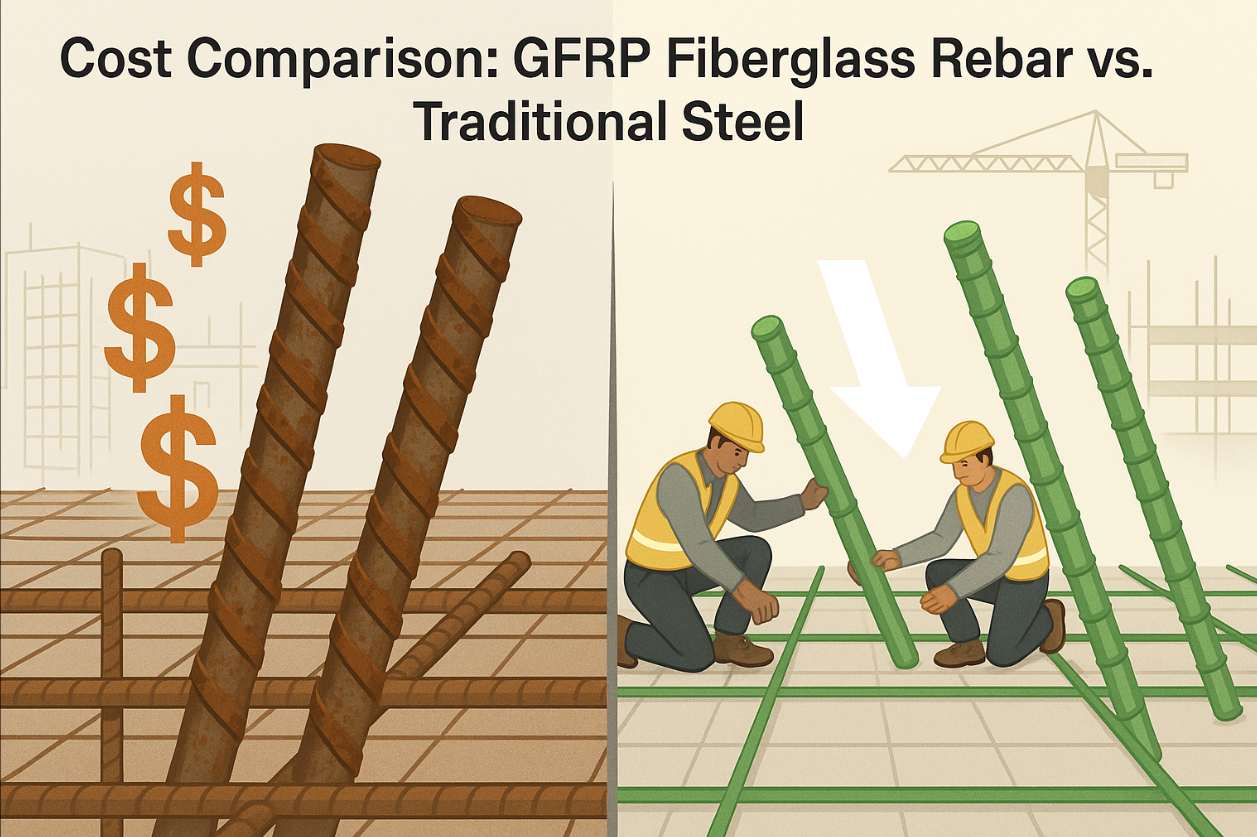- June 3, 2025
- Posted by: wellcoindustries
- Category: Rebar
Introduction
Rising steel prices, unpredictable supply chains, and ever‑stricter durability targets have forced project teams to rethink the reinforcing bar buried in their concrete. GFRP fiberglass rebar—a non‑corrosive, glass‑fiber‑reinforced polymer rod—has moved from niche bridges to mainstream parking decks and seawalls because it promises lower lifetime cost without sacrificing strength.
Wellco Industries, a vertically integrated FRP manufacturer, supports owners and contractors with transparent pricing and engineering assistance, making the switch painless for professionals in construction, agriculture, and soil‑ and water‑conservation markets.

Understanding Up‑Front Material Pricing
Comparing price per linear foot & per ton
At first glance, a ⅝‑inch steel bar may cost $0.75 per linear foot while the same diameter gfrp fiberglass rebar lists around $1.10. Yet steel weighs roughly 3.3 lb/ft versus 0.9 lb/ft for GFRP. When bids are normalized to “price per ton of installed tensile capacity,” the spread narrows to less than 8 %.
Key stat: the average project using GFRP consumes 63 % less weight for identical strength.
Supply‑chain drivers: glass fiber, resin, and steel commodity trends
Steel pricing rides the roller‑coaster of iron‑ore indices and energy costs. By contrast, GFRP cost is driven by E‑glass fiber yarn and epoxy resin, both of which have shown single‑digit CAGR over the past decade. This stability lets purchasing managers lock in pricing earlier and avoid painful change orders when metals spike.
Lifecycle Cost Considerations (The Hidden Numbers)
Corrosion‑related maintenance and replacement costs
NACE International pegs the annual global bill for corrosion at $2.5 trillion—almost 3.4 % of world GDP. Rusting rebar drives a large slice of this number through spalling repairs, traffic disruptions, and eventually teardown. Because gfrp fiberglass rebar is electromagnetically neutral and will not rust or pit, owners can eliminate seal‑coat cycles and major concrete patching.
Service‑life extensions: bridges, seawalls, wastewater plants
Independent testing shows that a pier reinforced with GFRP retains over 95 % of its tensile strength after 100 years of chloride exposure, whereas black bar can lose half its capacity in 20–25 years. Extending the design life from 50 to 100 years cuts the annualized reinforcement cost in half—a metric that resonates with municipal budget officers.
Installation & Handling Expenses
Labor savings from lighter weight and faster placement
Crews routinely report placing 40 % more lineal feet of GFRP per shift because bundles can be carried by two workers instead of hoisted by a crane. Faster tying also occurs—the bar’s lighter weight and memory‑free straightness reduce alignment corrections.
Equipment, freight, and on‑site safety implications
A flatbed that hauls 20 tons of steel (about 8,500 ft) can move nearly 60,000 ft of GFRP in the same trip, trimming freight invoices by up to 30 %. Fewer lifts mean fewer pinch‑point injuries and lower insurance modifiers—numbers safety managers track closely.
Case Study: 30‑Year Parking Garage Retrofit (Anonymized)
Up‑front vs. life‑cycle spreadsheet snapshot
| Cost Category | Steel Rebar | GFRP Rebar |
|---|---|---|
| Material & Delivery | $680,000 | $850,000 |
| Installation Labor | $410,000 | $290,000 |
| 30‑Year Repair Allowance | $1,200,000 | $120,000 |
| Total 30‑Year Cost | $2,290,000 | $1,260,000 |
Project engineer quote on TCO (Total Cost of Ownership)
“Our spreadsheet killed any debate. Even though the sticker price was higher, GFRP cut projected concrete repairs by 90 % and trimmed payback to less than five years,” notes the lead structural engineer.
Environmental & Compliance Impact on Costs
Carbon footprint, LEED credits, and ESG reporting benefits
GFRP production emits up to 70 % less CO₂ per delivered tensile unit than blast‑furnace steel. Projects may claim LEED v4 MR credits for innovative materials, and several state DOTs now award bid preferences for low‑carbon infrastructure—a direct monetary incentive.
Code approvals (ACI 440, ASTM) reducing design‑stage risk
The latest ACI 440.11‑22 design guide and ASTM D7957 material spec have cleared the way for GFRP in mainstream codes. Designers avoid costly “alternative material” submittals, saving weeks of schedule float.
When GFRP Is (and Isn’t) the Cost‑Optimal Choice
High‑chloride, de‑icing salt, or marine projects: highest ROI
If a structure sees constant salt spray, fertilizer runoff, or wastewater chemicals, switching to gfrp fiberglass rebar is nearly a no‑brainer. Payback times drop below three years for bridge decks in northern climates where de‑icing agents attack steel relentlessly.
Budgeting tips: hybrid designs, volume discounts from suppliers like Wellco
Where exposure is moderate, hybrid designs place GFRP in splash zones and steel elsewhere. Wellco Industries offers volume‑based discounts and private‑label packaging, letting distributors hit price targets without compromising durability.
Conclusion
GFRP’s higher ticket price is easily offset by lighter handling, lower freight, corrosion immunity, and environmental perks. When the spreadsheet accounts for the whole life of the asset, gfrp fiberglass rebar almost always wins. Ready to run the numbers on your next project? Contact Wellco Industries for a no‑obligation cost‑benefit analysis or to request detailed specifications.
Frequently Asked Questions
Q1. How does GFRP rebar affect concrete design codes?
Designers follow ACI 440 guidelines, which provide clear equations and safety factors, so no special approval is usually needed.
Q2. Can GFRP bars be bent on site like steel?
They arrive pre‑shaped from the factory; field bending is not recommended, but custom bends can be ordered to match bar schedules.
Q3. What is the typical lead time for large GFRP orders?
Wellco cites 4–6 weeks for container‑load quantities, about the same as domestic steel mills once fabrication is included.
Q4. Does GFRP require special concrete cover?
Standard cover depths apply; however, some designers reduce cover by 10–15 % because corrosion is no longer a concern.
Q5. Is GFRP compatible with magnetic‑based inspection equipment?
Unlike steel, it is non‑conductive, so GPR (ground‑penetrating radar) is recommended for locating the bars after placement.
